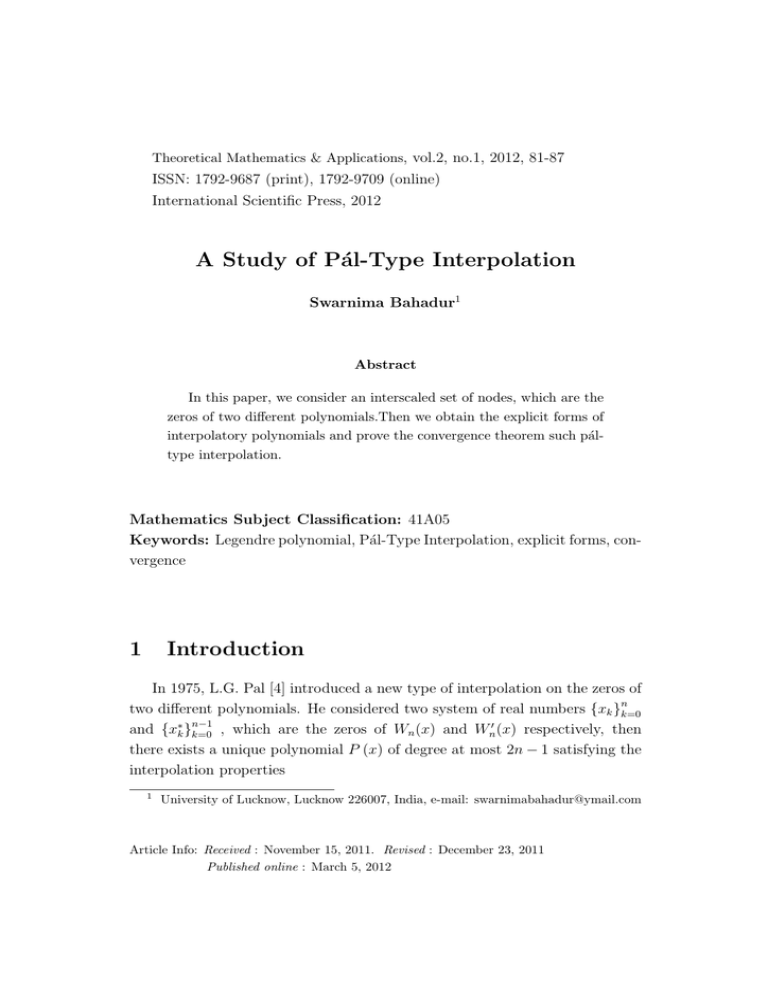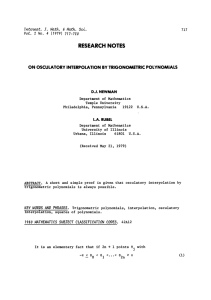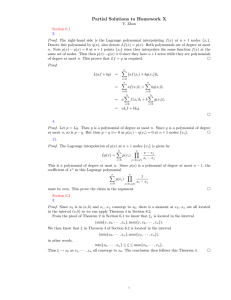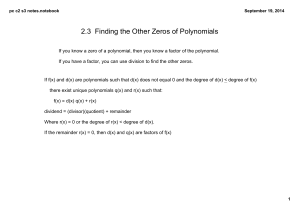, vol.2, no.1, 2012, 81-87 ISSN: 1792-9687 (print), 1792-9709 (online)
advertisement

Theoretical Mathematics & Applications, vol.2, no.1, 2012, 81-87
ISSN: 1792-9687 (print), 1792-9709 (online)
International Scientific Press, 2012
A Study of Pál-Type Interpolation
Swarnima Bahadur1
Abstract
In this paper, we consider an interscaled set of nodes, which are the
zeros of two different polynomials.Then we obtain the explicit forms of
interpolatory polynomials and prove the convergence theorem such páltype interpolation.
Mathematics Subject Classification: 41A05
Keywords: Legendre polynomial, Pál-Type Interpolation, explicit forms, convergence
1
Introduction
In 1975, L.G. Pal [4] introduced a new type of interpolation on the zeros of
two different polynomials. He considered two system of real numbers {xk }nk=0
n−1
and {x∗k }k=0
, which are the zeros of Wn (x) and Wn0 (x) respectively, then
there exists a unique polynomial P (x) of degree at most 2n − 1 satisfying the
interpolation properties
1
University of Lucknow, Lucknow 226007, India, e-mail: swarnimabahadur@ymail.com
Article Info: Received : November 15, 2011. Revised : December 23, 2011
Published online : March 5, 2012
82
A Study of Pál-Type Interpolation
(
P (xk ) = yk ,
(k = 1, 2, ....n)
and gave the explicit
0
∗
0
P (xk ) = yk ,
(k = 1, 2, ....n − 1)
formula of this polynomial.
Later on many authors have dealt with the above method of interpolation
on the various set of nodes i.e. on the real line or unit circle. In 2006, M.
Lénárd [3] considered the weighted (0, 2) pál-type interpolation problem on
the zeros of Legendre polynomial Pn (x) and gave the explicit formulae. In
a paper V.Srivastava, N. Mathur, P Mathur [5] have considered a new kind
of Pál-type interpolation. In other papers author [1, 2] has also considered
(0, 1; 0) and (0; 0, 1) interpolation on the unit circle.
In this paper, we consider two pairwise disjoint sets {xk }nk=1 and {yk }nk=1 ,
which are the zeros of Pn (x) and Πn (x) respectively with two additional conditions i.e. the function is also prescribed at ±1. The Pál-type interpolation
on these set of points means the determination of the polynomial, say Qn (x)
of degree (
≤ 2n + 1 satisfying the conditions:
Qn (xk ) = αk ; k = 0 (1) n + 1
(1.2)
Q0n (yk ) = βk ;
k = 1 (1) n
0
0
where αk s (k = 0 (1) n + 1) and βk s ( k = 1 (1) n) are arbitrary real numbers.
In section 2 we give some preliminaries, in section 3 we give explicit representation and in sections 4 &5 estimates and convergence of interpolatory
polynomials are respectively given.
(1.1)
2
Preliminaries
We shall use some well known facts about Legendre polynomials.
(2.1)
0
Πn (x) = (1 − x2 ) Pn−1
(x)
(2.2)
Π0n (x) = −n (n − 1) Pn−1 (x)
(2.3)
(2.4)
(1 − x2 ) Pn00 (x) − 2xPn0 (x) + n (n + 1) Pn (x) = 0.
(1 − x2 ) Π00n (x) + n (n − 1) Πn (x) = 0
(2.5)
(2.6)
Rx
Hk (x) = −1 xn Πn (x) dx
0
{x−n Pn (x)}x=yj = 0, for j = 1 (1) n.
83
Swarnima Bahadur
We shall require the fundamental polynomials of Lagrange interpolation on
zeros of Pn (x) and Πn (x), i.e
(2.6)
Lk (x) =
Pn (x)
for k = 1 (1) n
(x − xk ) Pn0 (xk )
(2.7)
lk (x) =
Πn (x)
for k = 1 (1) n .
(x − yk ) Π0n (yk )
For −1 ≤ x ≤ 1.
(2.7)
|Pn (x)| ≤ 1
1
2n 2
(2.9)
|Πn (x)| ≤
π
Let xk = cos θk (k = 1 (1) n) be the zeros of the nth Legendre polynomial
Pn , with 1 > x1 > x2 > .... > xn > −1, then by [6]
(2.10)
(2.11)
(
(1 − xk )2 ≥ k 2 n−2 ,
(1 − xk )2 ≥ (n − k + 1)2 n−2 ,
(
3
|Pn0 (xk )| ≥ ck − 2 n2 ,
3
|Pn0 (xk )| ≥ c(n − k + 1)− 2 n2 ,
k = 1, ..., n2
k = n2 + 1, ..., n
Let lk (z) be defined in (2.7) , then
(2.12)
2n−1
P
k = 1, ..., n2
k = n2 + 1, ..., n
|lk (x)| ≤ c log n.
k=1
For more details, one can see [6]
3
Explicit representation of polynomials
We shall write Qn (x) satisfying (1.2) as
(3.1)
Qn (x) =
n+1
P
k=0
αk Ak (x) +
n
P
k=1
βk Bk (x)
84
A Study of Pál-Type Interpolation
where Ak (x) and Bk (x) are fundamental polynomials of first and second
kind respectively each of degree ≤ 2n+1, uniquely determined by the following
conditions:
For k = (
0 (1) n + 1
Ak (xj ) = δkj ,
(3.2)
A0k (yj ) = 0,
j = 0 (1) n + 1,
j = 1 (1) n.
for k = 1 (1) n
(
Bk (xj ) = 0, j = 0 (1) n + 1,
(3.3)
Bk0 (yj ) = δkj ,
j = 1 (1) n.
Theorem 3.1. For k = 1 (1) n
(3.4)
Bk (x) = x−n Pn (x) {ak Jk (x) + bk Hk (x)}
where
(3.6)
Jk (x) =
(3.7)
ak =
(3.8)
bk =
Rx
−1
xn lk (x) dx
1
Pn (xk )
R1
xn lk (x) dx
−1
−ak R 1
.
xn Πn (x) dx
−1
Proof. Let
(3.9)
Bk (x) = x−n Pn (x) q (x) ,
where q (x) is a polynomial of degree at most 2n + 1.
One can check that Bk (xj ) = 0 , for j = 1 (1) n.
Similarly from (3.9) ,using the 2nd condition of (3.3) , i.e.
0
(3.10)
Bk0 (yj ) = {x−n Pn (x)}x=yj q 0 (yj ) + {x−n Pn (x)}x=yj q (yj ) = δkj ,
using (2.6) , we get
(3.11)
yj−n Pn (yj ) q 0 (yj ) = δkj
Hence we have
(3.12)
q 0 (x) = xn {ak lk (x) + bk Πn (x)} .
On integration , we get (3.4)
85
Swarnima Bahadur
Again
Bk0 (yk ) = ak δkj
we get (3.7) .For x = 1, we get (3.8) , which completes the proof.
Theorem 3.2. For k = 1 (1) n
(3.9)
Ak (x) =
(1 − x2 ) Πn (x)
Lk (x) +
(1 − x2k ) Πn (xk )
x−n Pn (x)
+
{Sk (x) + ck Hk (x)}
(1 − x2k ) Πn (xk ) Pn0 (xk )
where
(3.10)
with
(3.11)
(1 − x2 ) Π0n (x) + dk Πn (x)
dx
(x − xk )
(1 − x2k ) Π0n (xk )
dk = −
Πn (xk )
Sk (x) = −
ck = −
R1
−1
x
For k = 0, n + 1
(3.12)
(3.13)
Rx
xn
−1
n (1
− x2 ) Π0n (x) + dk Πn (x)
dx
(x − xk )
.
R1
n Π (x) dx
x
n
−1
Rx
x−n Pn (x) −1 xn Πn (x) dx
A0 (x) =
,
R1
Pn (1) −1 xn Πn (x) dx
R1
x−n Pn (x) x xn Πn (x) dx
An+1 (x) =
.
R1
Pn (1) −1 xn Πn (x) dx
Proof. Let Ak (x) =
(1 − x2 ) Πn (x)
Lk (x) +
(1 − x2k ) Πn (xk )
x−n Pn (x)
+
{Sk (x) + ck Hk (x)}
(1 − x2k ) Πn (xk ) Pn0 (xk )
Obviously Ak (xj ) = δkj ,
j = 1 (1) n and Ak (1) = 0 gives ck . From the
second condition of (3.2) , we get Sk (x) . Similarly one can find Ak (x) , for
k = 0, n + 1.
86
4
A Study of Pál-Type Interpolation
Estimation of Fundamental Polynomials
In this section, we prove the following:
Lemma 4.1. Let Ak (x) be defined in theorem 2, then
3
n
P
2
(4.1)
|Ak (x)| = O n log n , for k = 1 (1) n
k=1
(4.2)
3
|Ak (x)| = O n− 2 , for k = 0, n + 1 .
Lemma 4.2. Let Bk (x) be defined in theorem 1, then
1
n
P
(4.1)
|Bk (x)| = O n 2 log n , for k = 1 (1) n.
k=1
Lemmas 4.1 and 4.2 can be proved owing to conditions (2.7) − (2.12) and
the results in [6].
5
Convergence
In this section we prove the following.
Theorem 5.1. If f : R −→ R is continuously differentiable function , then
n+1
P
(5.1)
Qn (x) =
f (xk ) Ak (x), for −1 ≤ x ≤ 1
k=0
satisfies the relation
3
(5.2)
|Qn (x) − f (x)| = O n 2 ω2 f, n1 log n .
Remark Let f (x) ∈ C r [−1, 1] and f ’∈ Lip α, α > 12 , then sequence {Qn }
converges uniformly to f (x) , follows from (5.2) provided
(5.3)
ω2 f, n1 = O (n−1−α ) .
To prove Theorem 5.1, we shall need the following:
Swarnima Bahadur
87
Let f (x) ∈ C r [−1, 1].Then there exists a polynomial Fn (x) of degree ≤
2n − 2 satisfying inequality :
(5.4)
|f (x) − Fn (x)| ≤ cω2 f, n1 .
Proof. Theorem 5.1 Using (5.1) , (5.3) − (5.4) and Lemmas 4.1 and 4.2, we
get (5.2) .
References
[1] Swarnima Bahadur, Pál-type (0,1;0)-interpolation on the unit circle, Advances in Theo. and Appl. Math., 6(1), (2011), 35-39.
[2] Swarnima Bahadur, Pál-type (0;0,1)-interpolation on the unit circle, Int.
Journal of Math. Analysis, 5(29), (2011), 1429-1434.
[3] Margit Lėnard, On weighted (0.2)- type interpolation, Elect. Trans. Num.
Anal., 25, (2006), 206-223.
[4] L.G. Pál, A general lacunary (0; 0,1)-interpolation process, Annals Univ.
Budapest, Sect. Comp., 16, (1996), 291-301.
[5] V. Srivastava, N. Mathur and P. Mathur, A New Kind of Pál -type Interpolation, Int. J. Contemp. Math. Sciences, 6(45), (2011), 2237-2246.
[6] G. Szegŏ, Orthogonal Polynomials, Amer. Math. Soc. Coll. Publ., New
York, 1959.






